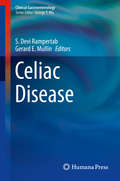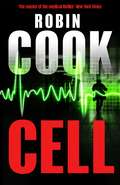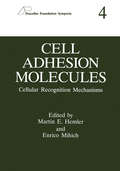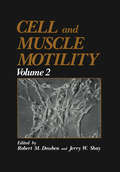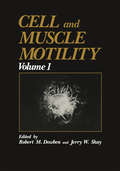- Table View
- List View
Celiac Disease (Clinical Gastroenterology)
by S. Devi Rampertab Gerard E. MullinCeliac Disease is an authoritative text intended to educate healthcare practitioners, gastroenterologists, physicians and nutritionists about the diverse manifestations, complications and management of gluten-sensitive enteropathy. The seventeen-chapter text provides the latest research on pathophysiology, including animal models, immunopathogenesis, genetics and the intestinal microflora. The book also features chapters on diagnosis, monitoring, complications and nutritional management, including therapies on the horizon. The text concludes with appendices that provide educational tools for symptom monitoring and dietary guidance.Written by specialists in their respective fields, Celiac Disease is a comprehensive resource that provides the healthcare practitioner an evidence-based practical guide to pathogenesis and therapy of celiac disease.
Celiac Disease: Methods and Protocols (Methods in Molecular Biology #1326)
by Anthony W. RyanThis volume provides detailed molecular analysis of the associated pathways and cell types involved in Celiac Disease, and embraces new technologies such as next generation sequencing. The book is divided into three parts: Part I gives a background overview with a number of reviews to describe the history and nature of the disease, its diagnosis, the role of animal models, and study designs for investigating genetic susceptibility. Part II describes molecular techniques, including tissue culture, isolation and cloning of relevant cell types, high content analysis of biopsies, and HLA genotyping. The final part of the book begins with an outline of scripting for data management, focusing on tools that are freely available to researchers who wish to explore them. It also describes analysis pipelines for bioinformatics prediction of antigenicity, quality control and analysis of GWAS data, and transcriptome analysis by next generation sequencing. Written in the highly successful Methods in Molecular Biology series format, chapters include introductions to their respective topics, lists of the necessary materials and reagents, step-by-step, readily reproducible laboratory protocols, and tips on troubleshooting and avoiding known pitfalls.Authoritative and thorough, Celiac Disease: Methods and Protocols brings together novel and more traditional methods in molecular biology and immunology, in order to provide a tool-kit for all stages for Celiac Disease research—from the practicalities of identifying, obtaining, stabilizing and maintaining high quality samples, to molecular analysis and bioinformatics.
Cell (A\medical Thriller Ser.)
by Robin CookGeorge Wilson, M.D., a radiology resident in Los Angeles, is about to enter a profession on the brink of an enormous paradigm shift, foreshadowing a vastly different role for doctors everywhere. A new smartphone app is being developed that is far more than a mere reference tool, rather it is a fully customizable personal physician capable of diagnosing and treating patients more efficiently than the real thing. It is called iDoc. George’s initial collision with this incredible innovation is devastating. He awakens one morning to find his fiancée dead in bed alongside him, not long after she participated in an iDoc beta test. Then several of his patients die after undergoing imaging procedures. All of them had been part of the same beta test. Is it possible that iDoc is being subverted by hackers – and that the US government is involved in a cover-up? Despite threats to both his career and his freedom, George relentlessly seeks the truth, knowing that if he’s right, the consequences could be lethal.
Cell Activation and Apoptosis in HIV Infection: Implications for Pathogenesis and Therapy (Advances in Experimental Medicine and Biology #374)
by Jean-Marie Andrieu Wei LuIn the past decade, the global efforts in the control of HIV disease were basically concentrated on the search for anti-retroviral agents. So far, anti-HIV therapies have been shown to be disappointing because of rapid development of drug-resistant mutant variants. Despite this drawback in the therapeutic fight against HIV infection, antiviral research should be actively pursued. However, failure of antiviral therapy indicates that other avenues of research should be rapidly explored with the same energy. In this setting, striking advances have been recently made in the dissection and understanding of the viro-immunological processes governing the progressive destruction of lymphoid organs associated with AIDS develop ment, and HIV-induced activation and apoptosis have been identified as key phenomena of the immune system destruction. This book assembles the most recent advances on basic and clinical aspects ofT-cell activationiapoptosis in HIV infection and their implications for immunotherapy. These data were presented at an international symposium held on July 11-12, 1994, in Paris. The book is partitioned into 21 chapters covering four comprehensive fields: 1) T-celllmacrophage activation and HIV infection; 2) Apoptosis and viropathogenesis of HI V disease; 3) Apop tosis and immunopathogenesis ofHIV disease; 4) Mediators ofT-cell activationiapoptosis and therapeutic applications. We hope that this book will assist the readers in understanding recent advances in the viro-immunopathogenesis of HI V disease as well as the rationales for potential immune cell-targeted therapeutic interventions.
Cell Adhesion and Cytoskeletal Molecules in Metastasis (Cancer Metastasis - Biology and Treatment #9)
by Anne E. Cress Raymond B. NagleThis volume highlights the expression of specific adhesion molecules within human cancer tissues. It details the expression signatures from published DNA microarray and immunohistochemistry studies. Coverage discusses the concept that the alteration of specific adhesion molecules influence the cancer migration ability and cancer damage responses, both features are essential for the survival of an invading tumor cell.
Cell Adhesion Molecules: Implications in Neurological Diseases (Advances in Neurobiology #8)
by Vladimir Berezin Peter S. WalmodCell Adhesion Molecules: Implications in Neurological Diseases contains review articles on recent developments in the field of neural cell adhesion molecules (CAMs). The main focus is on the role of cell adhesion molecules in various neurological and neurodegenerative diseases. This perspective has been essentially overlooked in recently published books on neural CAMs. In addition, the contributors cover many newly identified cell adhesion molecules and some that have not received much attention in recent years. This books fills an important gap in the currently available literature.
Cell Adhesion Molecules: Cellular Recognition Mechanisms (Pezcoller Foundation Symposia #4)
by Martin E. Hemler and Enrico MihichThe Fourth Annual Pezcoller Symposium entitled Adhesion Molecules: Cellular Recognition Mechanisms was held in Rovereto, Italy, June 24-26, 1992 and was focussed on the detailed mechanisms whereby cells utilize certain integral membrane proteins to perceive their surrounding environment and interact with it. With timely presentations and stimulating discussions this Symposium addressed the genetics and biochemistry of adhesion molecules, the regulation of their functions and their role in cancer and the immune system. Emphasis was given to adhesion proteins in the integrin family because of the widespread distribution of this group of molecules and its important role in essentially all eukaryotic biological systems. The regulation of integrin genes and their expression are discussed in detail, as are specific aspects of the genetics of fibronectin. The molecular basis for the regulation of certain integrins, the function of these proteins in determining cell adhesion, and the consequences of this adhesion for the function of the cells involved are discussed. The role of certain integrins in stimulating signal transduction, the essential involvement of integrins in conditioning the function of T and NK cells function, the heterogeneity of integrins and its biological consequences, and the role of cell adhesion molecules in tumor cells invasion and metastases are all extensively analyzed. New information was presented on the role of CD44 and splice variants in normal differentiation and tumor progression.
Cell Aging: Molecular Mechanisms And Implications For Disease (SpringerBriefs in Molecular Medicine)
by Christian Behl Christine ZieglerAging represents a physiological and per se non-pathological and multifactorial process involving a set of key genes and mechanisms being triggered by different endogenous and exogenous factors. Since aging is a major risk factor in connection with a variety of human disorders, it is increasingly becoming a central topic in biochemical and medical research. The plethora of theories on aging – some of which have been discussed for decades – are neither isolated nor contradictory but instead can be connected in a network of pathways and processes at the cellular and molecular levels. This book summarizes the most prominent and important approaches, focusing on telomeres, DNA damage and oxidative stress as well as on the possible role of nutrition, the interplay between genes and environment (epigenetics) and intracellular protein homeostasis and introduces some genes that have actually extended life spans in animal models. Linking these different determinants of aging with disease, this volume aims to reveal their multiple interdependencies. We see that there is no single “perfect” theory of aging and that instead it is possible to define what the authors call the molecular aging matrix of the cell. A better knowledge of its key mechanisms and the mutual connections between its components will lead to a better understanding of age-associated disorders such as Alzheimer’s disease.
Cell and Animal Models in Aging and Dementia Research (Journal of Neural Transmission. Supplementa #44)
by K. Plaschke D. Müller S. HoyerAlthough age has been recognized as a risk factor for late-onset dementia of Alzheimer type, its etiology is unknown as yet. Several age-related metabolic abnormalities may thus become important for the pathogenesis of the late-onset form. Studies at the cellular/molecular level in brain tissue are possible post mortem, but lack information on the beginning of the disorder. In this supplement, different approaches are dealt with how to induce structural and/or metabolic abnormalities in relevant cell cultures, in brain slices and in experimental animals, and how behavioral changes parallel the metabolic variations.
Cell and Gene Therapies (Advances And Controversies In Hematopoietic Transplantation And Cell Therapy Ser.)
by Miguel-Angel Perales Syed A. Abutalib Catherine BollardIn this book, experts in the field express their well-reasoned opinions on a range of complex, clinically relevant issues across the full spectrum of cell and gene therapies with the aim of providing trainee and practicing hematologists, including hematopoietic transplant physicians, with information that is relevant to clinical practice and ongoing research. Each chapter focuses on a particular topic, and the concise text is supported by numerous working tables, algorithms, and figures. Whenever appropriate, guidance is provided regarding the availability of potentially high-impact clinical trials. The rapid evolution of cell and gene therapies is giving rise to numerous controversies that need to be carefully addressed. In meeting this challenge, this book will appeal to all residents, fellows, and faculty members responsible for the care of hematopoietic cell transplant patients. It will also offer a robust, engaging tool to aid vital activities in the daily work of every hematology and oncology trainee.
Cell and Material Interface: Advances in Tissue Engineering, Biosensor, Implant, and Imaging Technologies (Devices, Circuits, and Systems)
by Nihal Engin VranaA significant portion of biomedical applications necessitates the establishment of an interface between the cells of the patient and the components of the device. In many cases, such as in implants and engineered tissues, the interaction of the cells with the biomaterial is one of the main determinants of the success of the system. Cell and Material Interface: Advances in Tissue Engineering, Biosensor, Implant, and Imaging Technologies explores this interaction and its control at length scales ranging from the nano to the macro.Featuring contributions from leading molecular biologists, chemists, and material scientists, this authoritative reference: Presents practical examples of cell and material interface-based applications Reflects the interdisciplinary nature of bioengineering, covering topics such as biosensing, immunology, and controlled delivery Explains the role of the cell and material interface in the context of cardiac and skin tissue engineering, nanoparticles, natural polymers, and more Cell and Material Interface: Advances in Tissue Engineering, Biosensor, Implant, and Imaging Technologies addresses concepts essential to biomaterial production methods and cell and material interactions. The book provides a solid starting point for elucidating and exploiting the different aspects of cellular interactions with materials for biomedical engineering.
Cell and Material Interface: Advances in Tissue Engineering, Biosensor, Implant, and Imaging Technologies (Devices, Circuits, and Systems)
by Nihal Engin VranaA significant portion of biomedical applications necessitates the establishment of an interface between the cells of the patient and the components of the device. In many cases, such as in implants and engineered tissues, the interaction of the cells with the biomaterial is one of the main determinants of the success of the system. Cell and Material Interface: Advances in Tissue Engineering, Biosensor, Implant, and Imaging Technologies explores this interaction and its control at length scales ranging from the nano to the macro.Featuring contributions from leading molecular biologists, chemists, and material scientists, this authoritative reference: Presents practical examples of cell and material interface-based applications Reflects the interdisciplinary nature of bioengineering, covering topics such as biosensing, immunology, and controlled delivery Explains the role of the cell and material interface in the context of cardiac and skin tissue engineering, nanoparticles, natural polymers, and more Cell and Material Interface: Advances in Tissue Engineering, Biosensor, Implant, and Imaging Technologies addresses concepts essential to biomaterial production methods and cell and material interactions. The book provides a solid starting point for elucidating and exploiting the different aspects of cellular interactions with materials for biomedical engineering.
Cell and Matrix Mechanics
by Roland Kaunas Assaf ZemelExplores a Range of Multiscale Biomechanics/Mechanobiology ConceptsCell and Matrix Mechanics presents cutting-edge research at the molecular, cellular, and tissue levels in the field of cell mechanics. This book involves key experts in the field, and covers crucial areas of cell and tissue mechanics, with an emphasis on the roles of mechanical forc
Cell and Molecular Biology for Non-Biologists: A short introduction into key biological concepts
by Lorenz AdlungThis book introduces the basics of cellular and molecular biology on a basic level including detailed explanations and examples. It lays the foundation for a systematic understanding of biology, which is essential in order to handle big data in biomedical research. Comprehension of what is measured, how it is measured and how to interpret results is a precondition for the development of novel therapies against diseases.Interdisciplinary research benefits from versatile approaches to generate and test hypotheses, which may lead to new discoveries. Therefore, it requires a new generation of biologists from diverse backgrounds - and they need this introduction.This book helps students and experts from e.g. computer science, informatics, mathematics, physics, and related fields or even if you are in sales and marketing and want to have a better understanding of the biology behind certain products.
Cell and Molecular Biology of Artemia Development (Nato Science Series A: #174)
by A. WarnerThe brine shrimp Artemia has become an important experimental system for studies of the developmental process. In recent years the shrimp has yielded considerable information on the pattern of development, bio chemistry, and gene structure and expression of crustaceans. This book is a compilation of research activity from twenty five of the most active re search laboratories working with brine shrimp in the above areas. It also represents the proceedings of a NATO Advanced Research Workshop held in Montreal, Canada, August 11-13, 1988. The book contains twenty nine full papers covering the major areas discussed at the workshop. In addition, one page abstracts representing seventeen poster presentations which were given at the workshop, and which were deemed to be most relevant to the theme of the book, are included. These are designated with an [al in the Table of Contents following the title of each paper. A considerable amount of discussion which took place during the workshop has not been included in the book because of space limitations. However, the editors will endeavour to make some of this in formation available at a later date through the Artemia Newsletter. In addition to the high percentage of invited speakers who attended and contributed to the workshop, the organizers would like to thank a number of participants who made valuable contributions to the major dis cussion sessions. These include: John Freeman, Michael Horst, Herman Slegers, Jack Vaughn, Frank Conte, Sandy McLennan, Clive Trotman and Patrick Sorgeloos.
Cell and Molecular Biology of Breast Cancer
by Heide SchattenHighlighting recent advances in our understanding of breast cancer, this book is intended for a wide audience as a reference book. Included are reviews of genetics, epigenetics, various aspects of cell and molecular biology, and several other areas of breast cancer that are aimed at determining new intervention sites for treatments and cures of the disease. The chapters are written by internationally recognized experts and include reviews of key topics in breast cancer research. Each chapter highlights the new aspects of specific research topics and the various impacts of designing new strategies as well as identifies new targets for therapeutic intervention. The topics addressed are selected to be of interest to patients, scientists, students, teachers, and anyone else interested in expanding their knowledge of breast cancer imaging, diagnostics, therapeutics, or basic biomedical research on breast cancer.
Cell and Molecular Biology of Endometrial Carcinoma
by H. Kuramoto M. NishidaThe 15th International Symposium of the Japan Human Cell Society on Cell and Molecular Biology of Endometrial Carcinoma brought together leading researchers from Japan and around the world. The papers collected here are the work of twenty-two leaders in their field and are organized in ten major categories. The first section, in vitro experimental systems, takes up the pioneering work by Kuramoto in 1968 and Nishida in 1980 in establishing, respectively, the HEC-1 and hormone-responsive endometrial carcinoma cell lines. Other topics include apoptosis, proliferation, and growth factors; cell cycle regulators; signaling pathways; angiogenesis; carcinogenesis; hormones and hormone receptors; genes and gene expression; endometrial receptivity; and chemo-resistance and -sensitivity. Presenting the latest work in the cell and molecular biology of endometrial carcinoma, this volume is a valuable resource for gynecologists, pathologists, and molecular biologists.
Cell and Molecular Biology of Ovarian Cancer: Updates, Insights and New Frontiers (Advances in Experimental Medicine and Biology #1452)
by Heide SchattenThe first of two companion books addressed the biology and clinical aspects of ovarian cancer. The companion title, Ovarian Cancer: Molecular & Diagnostic Imaging and Treatment Strategies, discussed both classic and the most recent imaging approaches for detection, early diagnosis and treatment of ovarian cancer. This volume, Cell & Molecular Biology of Ovarian Cancer, covers classic and modern cell and molecular biology as well as genetics, epigenetics, mitochondrial dysfunctions and apoptosis, cancer stem cells, angiogenesis, progression to metastasis, and treatment strategies including clinical trials related to ovarian cancer. Taken together, these two volumes form one comprehensive and invaluable contribution to the literature.The first of two companion books addressed the biology and clinical aspects of ovarian cancer. The companion title, Ovarian Cancer: Molecular & Diagnostic Imaging and Treatment Strategies, discussed both classic and the most recent imaging approaches for detection, early diagnosis and treatment of ovarian cancer. This volume, Cell & Molecular Biology of Ovarian Cancer, covers classic and modern cell and molecular biology as well as genetics, epigenetics, mitochondrial dysfunctions and apoptosis, cancer stem cells, angiogenesis, progression to metastasis, and treatment strategies including clinical trials related to ovarian cancer. Taken together, these two volumes form one comprehensive and invaluable contribution to the literature.
Cell and Molecular Biology of the Ear
by David J. Lim Janet StoeckertDr. Howard House, founder of the House Ear Institute and House Ear Clinic often uses the analogy of planting a seed when referring to establishing the House Ear Institute in 1946. Two grateful patients of Dr. House put forth the idea that his knowledge and innovative skills could be used to expand the understanding of hearing impairment and its treatment. Those two early patients provided the "seed money" to begin the Institute. Since that time, the growth has been phenomenal from a one-man laboratory to a multidisciplinary facility boasting over 175 scien tists, physicians, and support staff, all dedicated to the advancement of otologic research and education. Six years ago after a half-century of remarkable success with prosthetic and device research, the Institute began cultivating a new field of endeavor-cell and molecular biology. Don Nielsen, then the Institute's Executive Vice President for Research and Scientific Director, began exploring the potential for hair cell regen eration and presented his ideas to the Board of Trustees. For a period of six months, we did a lot of fact finding to assess what role the Institute might take in this excit ing new field.
Cell and Muscle Motility: Volume 2
by Robert M. Dowben Jerry W. ShayThe contributions to this volume were presented at a Symposium entitled "Current Topics in Muscle and Nonmuscle Motility" held in Dallas 19-21 November 1980 under the auspices of the A. Webb Roberts Center for Con tinuing Education, Baylor University Medical Center Dallas, and the Univer sity of Texas Health Science Center at Dallas. This very useful opportunity for a group of active investigators in motility to meet and discuss their latest findings was made possible in part by the income from an endowment fund established by a generous gift from Dr. Albert P. D'Errico in the Baylor University Medical Center. Dr. D'Errico was the first formally-trained neurosurgeon to practice in the Dallas area, the first Chief of Neurological Surgery, and a member of the Medical Board of the Baylor University Medi cal Center Dallas (1947 -1964). The income from this fund is used to promote the dissemination of up-to-date information in the Neurosciences, to provide intellectual stimulation, to add to the fund of knowledge, and improve the skills of neurosurgeons, neurologists, internists, and others in specialized fields of medicine. We are all indebted for this generous gift that made this enriching educational experience possible. We are also grateful for support the Symposium received from Electron Microscopy Sciences, Forma Scien tific, J. E. O. L. USA, Inc. , Ladd Research Industries, M. J. O. Diatome Co. , Or ganon Co. , Upjohn Co. , G. D. Searle & Co. , and Smith, Kline and French. Robert M.
Cell and Muscle Motility
by Robert M. Dowben Jerry W. ShayMotility is a fundamental property of living systems, from the cytoplasmic streaming of unicellular organisms to the most highly differentiated and devel oped contractile system of higher organisms, striated muscle. Research on var ious aspects of motile systems in muscle and undifferentiated or non muscle cells has been developing at an ever more rapid pace in the laboratories of investiga tors with a wide variety of backgrounds using methodologies varying from me chanics to the most sophisticated physical measurements. Significant contri butions to our understanding of motility are coming from the disciplines of cell biology, biochemistry, pharmacology, molecular biology, biophysics, and physiology. The findings have relevance not only to basic scientists but to clinicians in such diverse fields as cardiology and neurology and to scientists in the more traditional physical sciences. Cell and Muscle Motility is a new multivolume series of essays by distinguished research workers in various fields whose work has a common thread of dealing with one aspect or another of motility. The essays are meant to focus on topics of current interest, to be critical rather than exhaustive, and to indicate the current trends of research efforts. The series is intended to foster an interchange of concepts among various workers in the field and to serve as a reference for students and workers who wish to familiarize themselves with the most current progress in motility.
Cell and Muscle Motility
by Robert M. Dowben and Jerry W. ShayMotility is a fundamental property of living systems, from the cytoplasmic streaming of unicellular organisms to the most highly differentiated and de veloped contractile system of higher organisms, striated muscle. Although of motility have a long and in scientific investigations into the mechanisms teresting history, the knowledge of molecular processes, especially in the area of regulation of control of motility, has been developing at an ever more rapid pace with the utilization of multidisciplinary approaches from physiology, cell biology, genetics, biochemistry, pharmacology, and biophysics. In Volume 3, Cell and Muscle Motility continues the same philosophy as that of the preceding volumes. The essays are meant to focus on topics of current interest, to be critical rather than exhaustive, and to indicate the current trends of research efforts. The series is intended to foster an in terchange of concepts among various workers in a variety of disciplines and to serve as a reference for students and workers who wish to familiarize them selves with the most current progress in motility. Robert M. Dowben Jerry W. Shay Dallas vii Contents Chapter 1 Intermediate Filaments in Striated Muscle: A Review of Structural Studies in Embryonic and Adult Skelttal and Cardiac Muscle Maureen C. Price and Joseph W. Sanger 1. Introduction ................................................ .
Cell and Organ Printing
by Bradley R. Ringeisen Barry J. Spargo Peter K. WuCell and organ printing has become a hot topic of scientific pursuit. Since several early publications between 2000-2003 that demonstrated proof-of-concept, cell and organ printing has blossomed into a rich area for scientific exploration that is being performed by researchers across the globe. Research has thoroughly demonstrated that living cells can be printed via a number of actuations including electrospray, extrusion via micropens and ejection through photothermal, thermal or optical mechanisms. This topic has come of age and it is ripe for exploring the underpinnings of the research to date. We have included research that uses printing technology to deposit or guide cells for tissue engineering applications and for completeness, we have also included chapters describing bacteria printing, biomolecular printing that could be used to build growth factors or recruitment macromolecules into scaffolds, tissue microdissection, as well as live cell printing. The breadth of approaches includes 3D freeform fabrication, ink jet, laser guidance and modified laser direct write techniques. We hope that this book is not the final word but the first word, defining how these tools have been used to take the first steps towards the ultimate goal of creating heterogeneous tissue constructs. Only time will tell whether cell printers will truly become organ printers, but the technologies described in this book hold promise to achieve what the field of regenerative medicine requires - functional 3D scaffolds with multiple cell types differentiated into functional tissue!
